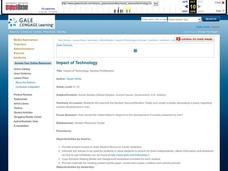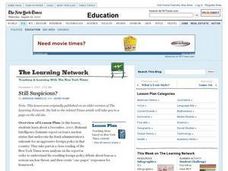Curated OER
Gauri and Prithvi: Nuclear South Asia
Students examine South Asian relations. In this international affairs lesson, students explore the relationship between India and Pakistan as they participate in role play activities and conduct research regarding the relations among...
Curated OER
Atomic Age Critical Thinking
Students research and discuss issues surrounding the atomic bomb and the concerns it raised and the consequences of dropping the atomic bombs on Japan. A variety of sample questions are provided to engage discussion.
Curated OER
Dancing in the Desert: The Genie
Fifth graders study nuclear destruction using visual literacy. In this nuclear destruction lesson plan, 5th graders work in groups to examine a group of pictures that show the destruction of a home by a nuclear blast. They discuss the...
Curated OER
One Step Closer to a Treaty
Students speak objectively about the nuclear disarmament issue and interpret sections of the Nuclear Non-Proliferation Treaty. They become more informed by these discussions and readings on the nuclear
Curated OER
Breaking News English: Iran Resumes Nuclear Work
For this English worksheet, students read "Iran Resumes Nuclear Work," and then respond to 47 fill in the blank, 7 short answer, 20 matching, and 8 true or false questions about the selection.
Curated OER
Debating the Bomb
Students research how the development of the atomic bomb affected people in World War II, participate in a debate about the bomb's use, and investigate how it has affected people's lives since 1945.
Curated OER
Supercomputer Breaks Its Own Record
Students tour the inside of a computer, and then step back in time to meet some of the people who contributed to computing technology's development. They write about the specific innovations they found to be the most interesting.
Curated OER
Cartoons for the Classroom: A Parody of Broken Promises
Parodies of political figures are the lifeblood of the editorial cartoons in a free press. North Korea's nuclear threat provides young political scientists an opportunity to hone their critical thinking skills as they analyze a...
Curated OER
The Cold War And Beyond
Young scholars interview an adult that grew up in the United States during the Cold War to develop an understanding of the concept of mutually assured destruction. They focus the interview on how the person dealt with the threat of...
Curated OER
Debating the bomb
Students research how the development of the atomic bomb affected people in World War II. In this American History lesson, students participate in a debate about the bombs use. Students investigate how it has affected...
Curated OER
Science of War
Tenth graders, from an environmental perspective, study the pros and cons of war. Distinctions between characteristics of biological, chemical and nuclear threats and the impact of economic development are considered.
Curated OER
Watershed Investigations
Learners find maps of the region to show rock formations and soil types and use GIS to compare radon levels. They describe three types of radioactive decay, interpret graphs, and follow steps to develop a nuclear bomb or energy.
Curated OER
The Reality of War
Students use research materials developed earlier. They synthesize data to formulate an argument for or against war. Students use their notes to address what the possible answers could be.
Smithsonian Institution
Cuban Missile Crisis
The United States—specifically John F. Kennedy—played a large role during the Cuban Missile Crisis. A history resource poses questions that encourage critical thinking as well as in-depth analysis of images from the time period.
The New York Times
Decision Point: Understanding the U.S.’s Dilemma Over North Korea
Simulate the Situation Room and analyze the US's relationship with North Korea. The plan starts off with a quick review and an examination of a online timeline that updates as the situation continues. Next, the class reads an article and...
Curated OER
Technology
Students trace and analyze the impact of the atomic bomb on warfare, society and government. They apply this process to other more modern technological inventions in our lives.
Curated OER
Still Suspicious?
Students read and analyze The New York Times news article "An Assessment Jars a Foreign Policy Debate About Iran." They answer comprehension questions, evaluate both sides of the debate, and write a one page report on the article.
Curated OER
Defense Mechanisms
Young scholars examine the Cold War roots of the recent debate over the construction of United States and Russian missile defense shields. They begin by reading and discussing the article, Putin Says Russia Would Counter U.S. Shield.
Curated OER
Surrounded by Radiation
Learners explore ways in which people are constantly exposed to naturally occurring and man-made sources of radiation. They create and play a board game featuring different hypothetical scenarios of radiation exposure.
Curated OER
What Was the Cold War?
A study of the Cold War can helps students learn about history through interviewing people who lived through this period.
Foreign Policy Research Institute
Understanding the Koreas
Though this resource was designed in 2005, US tension with North Korea remains a relevant topic for exploration and understanding. Unfortunately, this lecture and reading-based instructional activity is unlikely to engage the class. The...
Curated OER
"Role" Call
Students explore the positions of the members of the United Nations Security Council. They stage an enactment of a Council meeting by presenting findings to ambassadors who debate the best course of action.
Curated OER
Breaking News English: Africa
In this Africa worksheet, students read the article, answer true and false questions, complete synonym matching, complete phrase matching, complete a gap fill, answer short answer questions, answer discussion questions, write, and more...
Curated OER
The Dropping of the Atomic Bomb at Hiroshima and Nagasaki
Take an in-depth look at the historical events in Hiroshima and Nagasaki in this 69-slide PowerPoint. Photos, facts, and transcripts are outlined in this presentation in order to answer the stated essential question in slide 2: "What...

























